| |
| |

Painter, sponsor and collector of
Impressionists
Gustave Caillebotte, whose personal
works were forgotten until recently, was all together a recognized
painter and a generous patron of the Impressionist movement.
He was born in 1848 in a very rich family which made its
fortune in textiles industry then in real estate business as Baron
Haussmann was rebuilding Paris.
Engineer by profession, but also former student of the
Fine Arts School of Paris where he studied with Léon Bonnat,
he met Edgar Degas, Claude Monet,
and Pierre Auguste Renoir in 1874 and
helped them organize their 1st group exhibition in Paris this same
year.
|
|
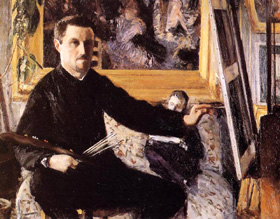
|
Self-portrait
with the palette
1879-80

Private
Collection
|
In 1873, he inherits the great fortune of his father and will
be financially independent for the rest of his life.
|
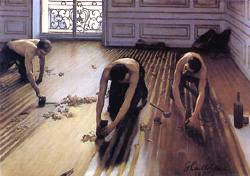
The floor scrapers
1875
Musée d'Orsay, Paris
|
|
In 1875, as he wishes to make his public beginnings as a
painter, he submitted a work to the Official Salon which was refused,
thus encouraging him to exhibit in 1876, with the aid of Renoir, at the
second exhibition of the Impressionist group. His works and in
particular the "The floor scrapers "
were noticed and appreciated. Consequently he will take part in the
subsequent exhibitions of the Impressionist Group.
|
Caillebotte was rich and generous and will financially help
throughout his lifetime his Impressionist friends by buying at high
prices their works and by supporting the expenses of their exhibitions.
He will be a co-organizer and co-financier of the 3th, 4th, 5th and 7th
Impressionist exhibitions, in which he will take part.
In 1881, he buys a house with garden in Petit-Gennevilliers
where he will create a number of his works. Highly skilled horticulturist,
he corresponds with Monet at Giverny and creates
orchises in his greenhouses.
Character with multiple facets, Caillebotte also was a racing
yachtsman who had a passion for speed and seeked to improve
his boats. Naval architec, he draws and builds his
boats in a workshop located on SNECMA's present site. There he will
create true thorough-breds of the river, with multiple innovations
(silk veil, external ballast, aerodynamic hulls, etc.) with which he
will gain many international titles.
| |
Caillebotte painted some 500 works in a style often more
realistic than that of his Impressionist friends. The painter will
illustrate himself particularly in views of Paris streets
made from high balconies, in scenes of working life,
natural landscapes of gardens and parks, and in nautical
scenes (on the Seine in Argenteuil and Yerres).
His great concern for a realistic painting, his colored
notes, and his treatment of light make him well a
great Impressionist painter whose work is original
and diverse.
|
|
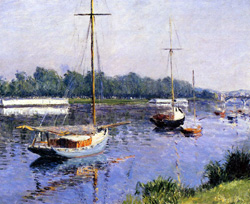
The basin at Argenteuil
1882
Private Collection
|
 CAILLEBOTTE'S LEGACY TO THE FRENCH STATE CAILLEBOTTE'S LEGACY TO THE FRENCH STATE
Caillebotte will make a donation of his collection, in his
will written in 1876, in these terms:
"I give to the French State the paintings which I have; nevertheless,
since I want that this donation be accepted and in such a manner that
the paintings go neither in an attic nor in a province museum, but well
in the Luxembourg Museum and later in the Louvre Museum, it is
necessary that a certain time passes before execution of this clause
until the public, I do not say understand, but admit this new
painting. This time may be twenty years at the maximum.
Until then, my brother Martial, and at his defect another of my heirs,
will preserve them. I request Renoir to be my
executor... "
Caillebotte was to die into 1894 of an attack of apoplexy. The
Academists, led by Gérôme,
then tried to prevent the entry in the artistic inheritance of France
of Impressionist works which had been constantly refused by the
Official Salon - in particular works of Cézanne which
formed part of the collection -. The Institute of France initially
refused the Caillebotte legacy to the French National Museums.
| |
In 1896, the French State however authorize the National
Museums to select some paintings of the embarassing Caillebotte's
legacy which might be exhibited in the Musee du Luxembourg.
They refused among these "drifts of an
unhealthy art" 27 paintings out of the 67 of the collection
and will accept: seven pastels of Degas, eight Monet, six Renoir, seven
Pissarro, five Sisley, two Cézanne and two Caillebotte - joined to the
legacy by Martial Caillebotte after the death of his brother - which
will be presented in an appendix of the museum of Luxembourg in 1897 .
The exhibition will cause violent movements and a
political scandal at the instigation of Gérôme and seventeen of his
colleagues, members of the Institute. Thus the Senate will be seized of
this problem.
|
|
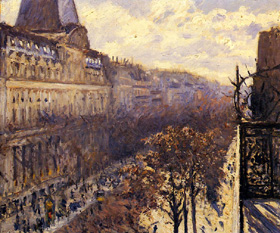
Boulevard des Italiens
1880
Private Collection
|
It is this donation, which Renoir had the
merit to impose to the French State after the death of Caillebotte,
which makes France have in its inheritance major works of Monet, Degas,
Sisley, Renoir... Most of the works of the legacy that were refused
were repurchased by a certain Doctor Barnes whose
collection of Impressionists is now envied by our national museums (An
exhibition of the Barnes Foundation took place at the
Musée d'Orsay in 1993-94)!
The Caillebotte collection will be integrated into the Louvre
Museum only in 1928, and is today in the Musée d'Orsay.
 CAILLEBOTTE and the CRITICISM of ZOLA CAILLEBOTTE and the CRITICISM of ZOLA
Zola , who will take the party of the Impressionists vilified by
critics and refused by the jury of the Salon, will be critical with
regard to Caillebotte of whom he will denounce "photographic" realism
at the time of the second Impressionist exhibition. The painter will
then present the eight following paintings: Floor scrapers ,
Young man playing the piano, Young man at his window, Lunch, After
Lunching and Two Gardens. Zola will thus comment on the talent of
Caillebotte in his Letters of Paris of June 1876:
"Caillebotte exposed "The floor scrapers" and "Young man
at his window" , of an astonishing relief. However, it is a
completely anti-artistic painting , a painting clear
like glass, of a middle-class kind by its exactitude. The photography
of reality, when it is not enhanced by the original print of artistic
talent, is a pitiful thing ".
At the time of the third Impressionist exhibition of 1877, Caillebotte
will present the six following paintings: "Paris street, rainy
weather", "The Bridge of Europe", "Portraits in the countryside",
"Portrait of Mrs C"; "Portrait" and "House painters" .
|
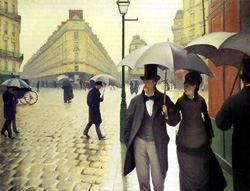
Paris street, rainy weather
1875
Art Institute of Chicago
|
|
Zola will then give an opinion definitely more
favourable in his Parisian Notes - an Exhibition : The
Impressionist Painters - 1877 - :
"At last , I will name Mr. Caillebotte, a young painter of the most
beautiful courage and who does not give up in front of full-size
modern subjects. His "Street of Paris by a rainy weather"
shows pedestrians, especially a man and a lady in the foreground which
are of a beautiful truth . When his talent will have softened a little,
Mr. Caillebotte will certainly be one of the boldest of the group".
|
Zola will overlook the presence of Caillebotte to the fourth
Impressionist exhibition. In 1880, he will again write about
"Naturalism at the Salon", where Caillebotte will expose his "Self-portrait"
, "In a Coffee" and "View from a balcony" .
"Mr. Caillebotte is a very conscientious artist, whose style is a
little dry, but who has the courage of great efforts and who seeks with
the most virile resolution".
The painter, opposed to Degas, will boycott the sixth exhibition. He
will return in force to the seventh while presenting seventeen
paintings, in spite of Pissarro's hostility and thanks to the support
of Monet. Monet and Caillebotte will not take part in the last
Impressionist exhibition of 1886.
|



